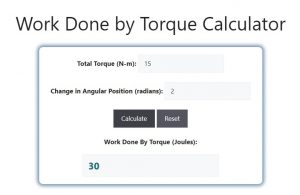About Work Done by Torque Calculator (Formula)
The Work Done by Torque Calculator is an essential tool for engineers and mechanics involved in analyzing rotational motion. Torque is a measure of the force that can cause an object to rotate about an axis. Understanding how much work is done by this torque is crucial in various applications, from automotive engineering to machinery design. This article will explain the formula used in the Work Done by Torque Calculator, guide you on how to use it, provide a practical example, and address frequently asked questions.
Formula
The formula for calculating the work done by torque is:
Wt = t * d(θ)
Where:
- Wt represents the work done by torque.
- t is the torque applied (in Newton-meters).
- d(θ) is the change in angular displacement (in radians).
How to Use
- Determine the Torque (t): Measure the torque applied in the system, typically in Newton-meters (N·m).
- Measure Angular Displacement (d(θ)): Determine the change in angular displacement, expressed in radians. You may need to convert degrees to radians if necessary (1 radian = 180/π degrees).
- Input Values into the Formula: Substitute the values of torque (t) and angular displacement (d(θ)) into the formula: Wt = t * d(θ).
- Calculate the Work Done: Perform the calculation to find the work done by the torque.
Example
Let’s calculate the work done by torque for a system with the following parameters:
- Torque (t): 15 N·m
- Change in Angular Displacement (d(θ)): 2 radians
Using the formula:
Wt = t * d(θ)
Wt = 15 N·m * 2 radians
Wt = 30 Joules (J)
This result indicates that the work done by the torque in this scenario is 30 Joules.

FAQs
- What is torque?
Torque is a measure of the rotational force applied to an object around an axis. - Why is work done by torque important?
It helps in analyzing the energy transfer in rotational systems, essential for machinery and engineering applications. - What units are used for torque and work?
Torque is measured in Newton-meters (N·m), and work is measured in Joules (J). - How do I convert degrees to radians?
To convert degrees to radians, use the formula: radians = degrees × (π/180). - Can I use this calculator for non-linear motion?
The calculator is specifically designed for rotational motion and torque. - What does d(θ) represent?
d(θ) represents the change in angular displacement, indicating how far an object has rotated. - How is torque calculated?
Torque can be calculated using the formula: t = F × r, where F is the force applied, and r is the distance from the pivot point. - What happens if the torque is constant?
If the torque is constant, the work done can be calculated using the same formula throughout the displacement. - Can I use this for mechanical systems?
Yes, it is widely used in mechanical engineering for analyzing the work done by motors and other rotational devices. - What is the significance of work done in physics?
Work done indicates the energy transferred by a force, essential for understanding system efficiency and performance. - How often should I calculate work done in a system?
It is advisable to calculate work done whenever there are changes in the system parameters or conditions. - What factors can affect torque in a system?
Factors include the magnitude of the force applied, the distance from the pivot point, and the angle of application. - Can this calculator be used for complex systems?
Yes, but ensure that all forces and torques are accounted for accurately. - What is the difference between work done by torque and linear work?
Work done by torque involves rotational motion, while linear work involves force applied along a straight line. - How do I ensure accurate measurements for torque?
Use calibrated tools and measure carefully to ensure precision in your calculations. - What tools can help measure torque?
Torque wrenches, dynamometers, and specialized torque measurement devices can provide accurate readings. - Can I use this formula for different types of machinery?
Yes, it is applicable to various machinery and applications involving rotational motion. - What are some real-world applications of this calculator?
Applications include automotive design, robotics, and any machinery requiring precise torque measurements. - Is there a maximum limit for torque calculations?
The limit depends on the material properties and design of the system; exceeding it can lead to failure. - What should I do if I receive an unexpected result?
Double-check your input values and calculations for accuracy, and ensure that all units are consistent.
Conclusion
The Work Done by Torque Calculator is a crucial tool for anyone involved in rotational systems, providing insights into energy transfer and system efficiency. By utilizing the formula Wt = t * d(θ), users can accurately assess the work done by torque in various applications. Regular calculations and adjustments based on system parameters can lead to improved performance and reliability in engineering practices. Understanding how to use this calculator effectively will enhance your ability to analyze and optimize rotational motion in your projects.